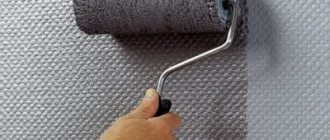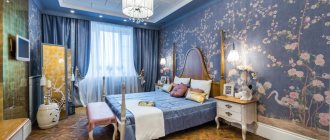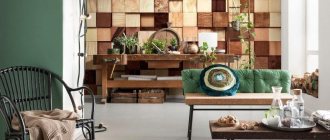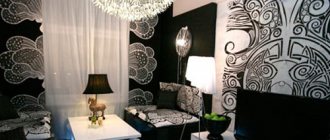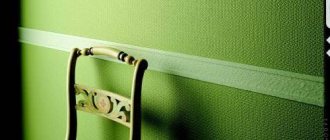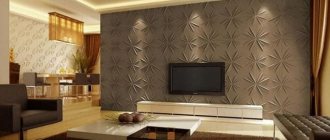Properties and characteristics
Wall paper wallpaper is a non-woven material with a pattern applied with a special paint. In their production, substances are used that do not allow the pattern to spread.
All components (often coloring pigments) are environmentally friendly. This ensures safe living for people in rooms where the walls are decorated with paper wallpaper.
The canvases are based on crushed wood, which at one stage turns into a suspension. During further processing, the wood pulp is bleached, cleaned and made more viscous. For greater strength, the canvas is laminated over the applied pattern.
Depending on the texture, paper webs are classified into smooth (the pattern is applied by printing) and embossed, having a voluminous texture, a coarse fiber structure or duplex embossing.
Paper wall panels with duplex embossing are considered one of the most durable, since they consist of several layers. Coarse fiber wallpaper also includes several layers with a middle layer of wood chips.
All subtypes of relief canvases are stronger and denser, which allows them to well reinforce the surface and mask minor defects.
Quality characteristics depend on the weight of the wallpaper, they can be:
- Light, weighing 110 g per 1 sq.m.
- Average weight - from 110 g to 140 g per 1 sq.m.
- Heavy, weight is more than 140 g per 1 sq.m.
Accordingly, the lighter the canvas, the lower its density and strength.
Choosing an adhesive solution
Choosing glue for paper wallpaper is not difficult, but each of us wants to buy the best option. There are several tips when choosing an adhesive solution:
- The best glue will be from the same manufacturer as the wallpaper.
- Wallpaper glue can be made at home
- Among the various brands, Belarusian, German and Russian adhesive solutions are popular
- Use diluted glue as a primer
Paper wallpaper in the interior
Rasch glue - contains starch and dispersion powder. The advantage of the material is that it is universal and can be used to easily stick vinyl, paper and even textile wallpaper. The French quelyd mixture is characterized by low consumption and affordable cost.
The product will firmly glue the canvas to the base; a special feature is the additional indicator, which makes it clear whether the glue is applied correctly or not. Antiseptic additives prevent the development of mold and mildew - additional protection against rapid deterioration. Often among home craftsmen the question is whether it is possible to glue paper wallpaper yourself with non-woven glue. The answer is yes, but the following details should be taken into account:
- The instructions indicate the proportions for diluting the glue. They require the strictest adherence
- After the second kneading, you need to wait at least 10 minutes and then begin to carefully apply the mixture to the wallpaper.
- Take a sample of wallpaper and check the absorbency of the glue on it - paper sheets absorb a lot of water
Types of paper wallpaper
Single layer smooth
The thinnest, used for perfectly smooth walls. They are characterized by low cost, lack of resistance to dampness and mechanical damage. The official name is simplex.
Multilayer paper wallpaper
They are duplex and can hide minor imperfections on the walls. They are produced by gluing two layers, mainly paper with cellulose, textile (for example, non-woven wallpaper). Some of them can withstand wet cleaning.
Photo wallpaper
Perhaps the most popular in this category. They are a two-layer paper base with a photocell applied to the front side.
Foam wallpaper (foam wallpaper)
We can say that it is still a novelty among wall finishing materials. Foam wallpaper is attractive due to its textured surface and original design. They are made using acrylic polymer foamed at high temperatures.
Embossed (cached) paper-based wallpaper
The top layer of this two-layer wallpaper is convex-relief due to embossing.
Structural
They also appeared not so long ago. They are produced in a rather original way - finely dispersed elements are applied to a paper base. It can be anything - shell rock, sand, fine-textured shavings, etc. Another layer of paper is glued on top, after which the entire structure is rolled with a press.
Moisture-resistant wallpaper
They contain at least three layers - a base, a decorative surface and a protective layer of synthetic components - latex or varnish.
Examples of photos in the interior of rooms
Photo examples of wall decoration in the interiors of various rooms.
Living room
Wallpaper with various prints or combined products will suit the living room; they will effectively complement the living room and make it truly irresistible. Such a multifunctional room should always have a harmonious, complete and unified image.
Kitchen
For the kitchen, washable types of paper sheets are an excellent option, from which various contaminants can be easily removed.
The photo shows a small kitchen and paper wallpaper with a bright print on the walls.
Bedroom
Thanks to the huge range of colors, you can create an original design using paper products. Plain canvases or models decorated with patterns and designs will not only add harmony and completeness to the interior picture, but will also add warmth and coziness to the atmosphere.
The photo shows a bedroom in an oriental style, decorated with pink paper wallpaper with designs in the form of birds.
Children's
Paper wallpaper, due to its environmental friendliness and safety, is not harmful to health and is the most acceptable finishing option for a nursery. Products with images of cute animals or favorite cartoon characters will add a certain mood to the atmosphere.
Hallway
Duplex models will be a practical option for the hallway. They not only have excellent moisture-resistant and wear-resistant qualities, but also perfectly hide various irregularities on the surface of the walls. The canvases can also be varnished so that they do not get dirty.
Disadvantages and advantages of wall paper wallpaper
An indisputable positive feature is environmental friendliness. The natural components of paper wallpaper and adhesive composition make it possible to use them wherever special requirements are imposed on the cleanliness of the atmosphere. This includes bedrooms and children's rooms.
It is impossible not to note the good soundproofing properties. In some cases, these coatings can reduce the thermal conductivity of walls. It also has good ability to allow air and moisture to pass through. Accordingly, there is no need to be afraid of the appearance and proliferation of various kinds of unpleasant small things - microorganisms, mold, fungus.
Flaws
A significant flaw is high moisture absorption. Therefore, it is not recommended to glue them in rooms where humidity levels are above average.
Fragility is another disadvantage of paper wallpaper. After two or three years of use, they lose their aesthetics. In addition, they are susceptible to abrasion.
Consequently, places where walls are frequently touched (switch area, etc.) look sloppy and spoil the overall appearance of the interior.
The paper surface quickly fades when exposed to UV rays. This factor is especially important when there is a large amount of furniture. If rearranged, there will be a significant difference in color.
What is the best way to clean and care?
These models require very delicate care. Paper products that do not have moisture-resistant qualities can only be cleaned using the dry method.
Care instructions
A few recommendations for proper care:
- To remove small dirt and dust, use a dry brush.
- You can also get rid of minor traces of dirt using a regular office eraser.
- Difficult stains can be removed using special powders or bleaches, but they are only suitable for plain white items.
How to wash paper wallpaper?
Proper care will allow paper finishing materials to retain their original appearance for a long time. A complete list of methods and means for cleaning canvases can be found in the article “how to wash wallpaper.”
- To avoid streaks, paper products should only be washed from bottom to top.
- Then you need to dry the canvas with a paper towel.
Choosing good paper wallpaper
When choosing, you should consider some nuances:
- It is better to cover walls with roughness and unevenness with multi-layer wallpaper with a convex pattern.
- In rooms located on the south side, it is recommended to glue wallpaper in cool tones. Warm shades are selected for the north side.
- Horizontal stripes on the wallpaper will visually lower high ceilings. Vertical stripes are ideal for low rooms.
- The purpose of the room plays a big role in the choice. If bright colors are appropriate in a children's playroom, then pastel and matte shades are more suitable for a bedroom, and calm, discreet tones are more suitable for an office.
- Color solutions should also be selected depending on the furniture and decorative elements.
- The covering purchased for a nursery or bedroom should not belong to group M-2, that is, washable. This is due to the polymer (non-ecological) composition of the coating.
- To choose a truly high-quality paper material, you should pay attention to the density - it should be at least 110 - 140 g.
An important factor: trellises with large patterns require adjustment, and accordingly, a good supply is needed.
Helpful information
By the way, when choosing paper sheets, it is important not to make a mistake in choosing the working personnel who will carry out the installation.
- Since paper trellises are subject to stretching when applying liquid glue, installation requires professional skill and it is advisable to turn to experts in their field. Especially in cases where the room is decorated with expensive types of paintings from well-known companies, and every mistake will cost lost money or the inability to achieve the desired stylistic direction.
- Installation difficulties are also associated with surface preparation, because a thin product is offered that is not able to cover roughness and will have to be laid on a perfectly flat layer.
- It is also important to take into account the parameters of the canvas, such technical characteristics as the ability to withstand ultraviolet radiation, resistance to moisture, temperature changes, and the method of gluing and removal. These are the main properties of roll coatings that you need to pay attention to, which are indicated on the product labeling.
Yes, paper wallpapers are quite capricious and it’s definitely not easy to glue them, but the look that can be achieved with their use is worth the money and time invested.
Wallpaper calculation
To find out how many rolls you need to purchase for a certain room, you can make simple calculations. First, the height/width of the walls is measured (the height is measured with an allowance for the baseboard, that is, +5 or 10 cm. If the room is 2.2 m high, add 5 cm, we get 2.25).
Of course, the doors and windows will not be covered, but it is better to leave a supply of wallpaper than to have a shortage later, so we count all openings into the total number.
Divide the width of the room by the width of the roll (standard – 0.53 cm). That is, with a value of, for example, five meters, we get: 5/0.53 = 9.43 stripes. We round up - 10. We have already obtained the height - 2.25. The standard roll length is 10 m. Accordingly, the height of one roll produces 4 strips (10/2.25=4.4).
Only whole values are taken into account, without fractions, since it is impossible to create a whole strip from scraps.
It remains to divide the total number of strips by the number of strips in one roll: 10/4 = 2.5. No one will sell two and a half rolls, so we buy three.
But if the budget is limited, you can make more accurate calculations by calculating the unpasted window and door openings from the total value. Perhaps in the end it will be possible to get by with two rolls.
Marking and cutting
Before gluing paper wallpaper, you need to measure the height of the room. Measurements from floor to wall to ceiling should be taken in different places. The largest indicator is taken as the basis for cutting.
The rolls are inspected and unpacked.
It is convenient to cut the material using a sharp knife with a wide and long blade. Before cutting, it is important to correctly adjust the design. The alignment is done on the floor with the material face up.
The strips are adjusted according to the design, measured and cut. It is more convenient to adjust the design by rolling out two rolls at once.
On some packages, the manufacturer already indicates the reserve for selecting a pattern. Usually it is 6-10 cm. An exception would be wallpaper with a very large pattern.
Paper embossed with metal-containing inks
This group of wallpaper coverings is distinguished by the fact that in addition to the rough relief surface, the latter is additionally decorated with pearlescent pigments, metal-containing paints, and various types of glitter.
example of duplex embossed with metal-containing and pearlescent paints
This decoration allows you to give the wallpaper a more original and attractive aesthetic appearance. It should be especially noted that it sells only environmentally friendly products, checking the safety of all substances used for the production of duplex wallpaper.
Advantages
The demand for this finishing material is explained by its many advantages:
- reasonable price;
- environmental friendliness (main material - paper);
- versatility (suitable for finishing walls and ceilings in almost any premises);
- hypoallergenic;
- a wealth of colors, large and small ornaments, reliefs;
- ease of installation and dismantling;
- the presence of an additional protective layer in some types of paper wallpaper (in such cases, wet cleaning is allowed);
- ease of care.
Paper wallpapers come in single-layer and double-layer types. There are also coatings intended for painting and treatment with impregnations.
The glue that is used to cover surfaces with this material is made from natural materials.
This coating can be used not only for decorating surfaces in residential premises, it is also used in offices.
Walls “dressed” in such wallpaper are breathable, that is, they “breathe”.
Children's paper wallpaper, due to its environmental friendliness, richness of colors and designs (there is material with cartoon characters), will become a real decoration for your child's room.
Fiberglass or paintable wallpaper
The main material used is fiberglass fabric; the composition also contains quartz sand, dolomite, and soda. For painting work, only the base is prepared; for decorative decoration, special decorative weaving is made. Mainly used in offices. It does not prick when touched, unlike glass wool. It is recommended to paint with latex or water-based paints.
| Advantages | Flaws |
|
|
Textile natural wallpaper
The composition of natural wallpaper is based on high-quality non-woven coating, unbleached or rice paper. On which highly decorative and natural material is applied in the form of cork, bamboo, reed, jute, veneer, seaweed. The first variants appeared in Ancient China, however, they became widespread only recently. You can often find synthetic analogues.
| Advantages | Flaws |
|
|
Attention! Do not clean natural wallpaper from dust using wet cleaning. It is permissible to use a vacuum cleaner or a long-haired brush.
Acrylic
Acrylic wallpaper, like vinyl, usually consists of two layers. On a non-woven or paper base, the decorative layer is made of foamed acrylic.
Wallpaper ProSpero Baby&Kids 2310-DW-A, RUB 3,575.
| Advantages | Flaws |
|
|
Non-woven wallpaper
The basis is non-woven non-woven material. It is produced by applying a polymer to a base of cellulose fibers. The composition of the resulting material is very similar to paper. Used for painting if foamed vinyl is applied to the non-woven base.
Geometric non-woven wallpaper PL11001-12, Leroy Merlin, Price — 352 rub.| Advantages | Flaws |
|
|
Attention! According to GOST 6810-2002 “Wallpaper”, non-woven wallpaper is considered safe if it does not contain a vinyl layer. This option is extremely difficult to find and the cost is much higher. The relevant GOST must be indicated on the packaging.
Beautiful and long lasting colors
In addition to the disadvantages, these models also have a number of advantages. This is not only a low price tag, but also a constant color - these are the main positive features of this wallpaper.
Vinyl wallpapers
Vinyl wallpaper is considered to be products based on paper or non-woven fabric, with a front layer of polyvinyl chloride (in simple words - vinyl) applied to them. We recommend using it for the kitchen and hallway.
| Advantages | Flaws |
|
|

